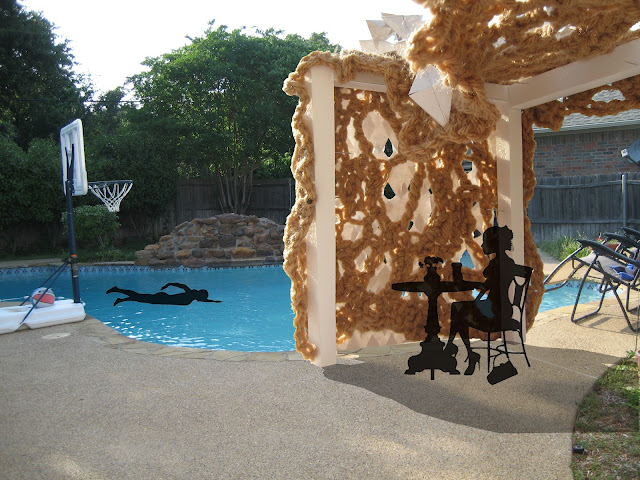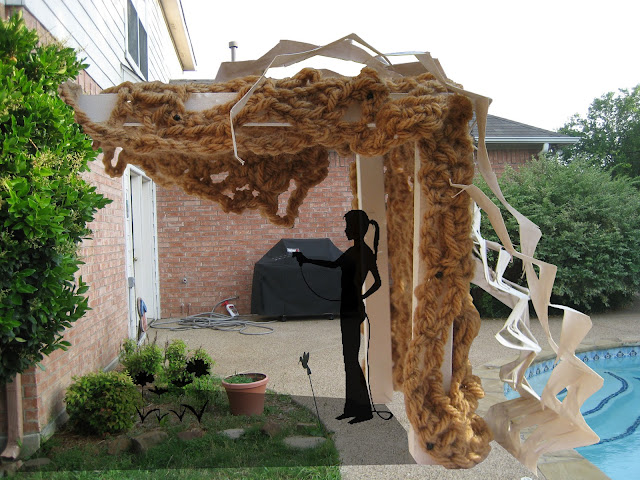Monday, May 7, 2012
Sunday, May 6, 2012
Establishing a Design
Phase 3: Design Development
The screen will be connected to a geothermal pump that brings water from underground to the cooling pad. In addition to this, the rubber ribs/louvers are designed in such a way that they can transport water run-off from the rain to the cooling pads. Thinking about the spines of the cactus, the ribs/louvers have a photovoltaic film on the outer layer allowing them to collect energy from the sun throughout the day to be used later.
I see this design being used for three different purposes:
1. An outdoor scenario
2. An interior partition or wall
3. Replacing the screen on a window
My next goal is to try to make the entire structure stand on its own without any structural support like beams or columns.
Week 17: April 24 2012-May 1, 2012
After establishing some of my ideas through sketches, I realized that there were two that stood out the most to me even when designing them. I found the modular design to be interesting because it reminded me of some of the unique ribs found on Barrel cactus. Through my research I know that the shape of the ribs and how they are oriented plays a huge role in how the cactus cools itself. The flexible storage ribs was equally interesting to me because of the way the ribs curve up and grow from the ground then attach to the house.
After establishing some of my ideas through sketches, I realized that there were two that stood out the most to me even when designing them. I found the modular design to be interesting because it reminded me of some of the unique ribs found on Barrel cactus. Through my research I know that the shape of the ribs and how they are oriented plays a huge role in how the cactus cools itself. The flexible storage ribs was equally interesting to me because of the way the ribs curve up and grow from the ground then attach to the house.
I decided to merge these two ideas into a design that contained modular rubber ribs, the rib shape I found most interesting/effective and a design that comes from the ground and connects to the home.
The screen will be connected to a geothermal pump that brings water from underground to the cooling pad. In addition to this, the rubber ribs/louvers are designed in such a way that they can transport water run-off from the rain to the cooling pads. Thinking about the spines of the cactus, the ribs/louvers have a photovoltaic film on the outer layer allowing them to collect energy from the sun throughout the day to be used later.
I see this design being used for three different purposes:
1. An outdoor scenario
2. An interior partition or wall
3. Replacing the screen on a window
My next goal is to try to make the entire structure stand on its own without any structural support like beams or columns.
Monday, April 23, 2012
Programming It
Phase 3: Design Development
Week 15: April 16 2012-April 21, 2012
Moving in a bit of another direction. I just gave my midterm presentation for the Deserted Solution and some ideas came to mind. I would like to not necessarily create an extension to a home, but an ability for people to re-engage with the outdoors during the hottest times of the year. In the American Southwest, at times people are stuck in air conditioning for up to 6 months of the year. At the end of the day, the psychological effect and mental health related issues of not being capable of being outdoors, out-weigh the money and energy issues that go into air conditioning this region. I am still focusing on the Barrel cactus as my inspiration towards a cooling supplement, but with another twist on the final design. The design will be an easily attachable structure (a screen, a curtain, wall system, etc.) that can be used for any existing building. The structure provides the cooling comfort that is necessary to be outdoors, while at the same time does not block the view to the outside world. Here are some beginning ideas and inspirations towards the final outcome of my graduation project using biomimicry as a basis for a design solution...
Moving in a bit of another direction. I just gave my midterm presentation for the Deserted Solution and some ideas came to mind. I would like to not necessarily create an extension to a home, but an ability for people to re-engage with the outdoors during the hottest times of the year. In the American Southwest, at times people are stuck in air conditioning for up to 6 months of the year. At the end of the day, the psychological effect and mental health related issues of not being capable of being outdoors, out-weigh the money and energy issues that go into air conditioning this region. I am still focusing on the Barrel cactus as my inspiration towards a cooling supplement, but with another twist on the final design. The design will be an easily attachable structure (a screen, a curtain, wall system, etc.) that can be used for any existing building. The structure provides the cooling comfort that is necessary to be outdoors, while at the same time does not block the view to the outside world. Here are some beginning ideas and inspirations towards the final outcome of my graduation project using biomimicry as a basis for a design solution...

Tuesday, March 20, 2012
Getting Underneath the Skin Part II
Phase 2: Schematic Design
Week 11: March 17, 2012-March 20, 2012
The more I continue to analyze and translate the barrel cactus into architecture, the more I question how I am doing in terms of approaching my topic of biomimicry accurately. I had an interesting past week. I went to BRIT, the Botanical Research Institute of Texas and spoke with a very helpful Barney L. Lipscomb. Barney helped me to understand that there are 6 species of barrel cactus and that I am studying the Ferrocactus genus/Echinocactus genus (what is commonly known in the America's as the barrel cactus). Barney also helped give me some names of highly regarded biologists and researches that I am currently attempting to communicate with about the project.
On a design note, this past week I dove back into the insides of the cactus. I am a visual person and because of that I decided to dissect the closest thing I could find to a barrel cactus, and that was a prickly pear cactus. Dissecting the prickly pear was very helpful to understand what the cortex tissue really is and how it works. I was amazed by the thickness of this water storage tissue and how moist it is inside. This led me to designing the cooling pads another way. I still think they need to be an absorbent natural material like cotton, but I think their design should relate to the cortex tissue and its cells. Take a look at my new ideas and inspirations...
This Thursday I have an appointment with a professional knitter/crocheter and am going to try to improve my crochet skills in order to achieve the look I want.
Tuesday, March 13, 2012
Connecting Everything Together
Phase 2: Schematic Design
Week 10: March 8, 2012-March 13, 2012
I will be designing an extension to a home. This extension is a space where individuals can step into and enjoy being connected with the outdoors, even in the most humid/hottest times of the year. I am using my home as a case study for how the design will work and function. Please take a look...
Wednesday, March 7, 2012
Thursday, March 1, 2012
Subscribe to:
Comments (Atom)

























































